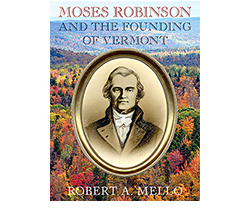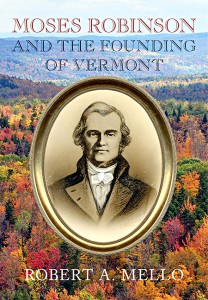
 copyright the Chronicle December 17, 2014
copyright the Chronicle December 17, 2014
Moses Robinson and the Founding of Vermont by Robert A. Mello. Published by the Vermont Historical Society, 2014. 450 pages with footnotes and bibliography. $34.95
Reviewed by Paul Lefebvre
Robert A. Mello is a better historian than he is a biographer. Perhaps that’s because his writing lacks the flair we look for in reading about people whose lives merit a biography. Still his recent biography of Moses Robinson and the role he played in Vermont’s formative years has arrived at a fortuitous moment.
In 1789, Vermont’s second election for governor was thrown into the Legislature as neither candidate had achieved a majority, as required by the state’s Constitution.
Out of 2,865 votes cast, Robinson had polled 746, making him runner-up to the incumbent, Thomas Chittenden, whose 1,263 votes were just 170 shy of achieving a majority.
The election went to the Legislature with Governor Chittenden pegged as the sure winner. Robinson was still at home in Bennington when his brother David and a troop of horsemen delivered the news: The Legislature had elected Moses Robinson as Vermont’s second governor.
As everyone knows, while precedents are set by history, there are no assurances history will repeat itself when legislators meet next month to elect a governor. We read history to see who we were, not what we will do next.
Who was Moses Robinson? The name has not jumped off the pages of previous histories about Vermont, even though he was a contemporary of Ethan Allen. Perhaps therein lies the problem. Who could equally share the limelight that history has turned on the man who stormed Fort Ticonderoga by surprise and captured it “in the name of the great Jehovah and the Continental Congress”?
Such a figure makes for good biography, but does it make for good history? Mello doesn’t think so.
“Vermont was built from the bottom up by pioneers who braved the wilderness looking for economic opportunity, freedom of worship, and personal autonomy,” he tells in the early going. And clearly Moses Robinson was not only one of them, but was one of their most resourceful leaders.
As one of Vermont’s young Turks who fought with an admirable willingness against the foreign troops of Britain and France as well as the New Yorkers — who wanted to claim much of southern Vermont as their own — Robinson may have had a political life without equal in Vermont’s evolution from a frontier to a republic to a state.
As a public official he held just about every office that either town or state could offer. He was a town moderator, town clerk, treasurer, and selectman while a resident of Bennington. He was a delegate to the state’s constitutional convention, a member of the Governor’s Council, as well as an agent to the Continental Congress to “vindicate Vermont’s right to be independent” against land claims from New York.
And as a fitting subject for an author who is presently a sitting Superior Court judge, Robinson was also the state’s first Chief Justice. But it was as a member of the constitutional convention in 1786 that Vermonters may owe him their greatest debt of gratitude.
Written in 1777, Vermont’s first constitution created a Council of Censor as a kind of a public watchdog committee, to review the work of government officials every seven years. Meeting in 1786, the council proposed making changes in the Vermont Constitution.
According to Mello, these changes included removing the right of people “to hold themselves, their houses, papers and possessions free from search and seizure.” The council further proposed to strike the constitutional guarantee that extended the vote to every man “of a quiet and peaceable behavior.”
Under the council proposal, voting would be restricted to property holders, and representation to the General Assembly would be based on a town’s property value rather than the number of its inhabitant.
Mello tells us there are no surviving records of how delegates voted on the proposals when they met in 1786 at the constitutional convention in Manchester. But arguing from what he knows about Robinson’s principles and his unswerving belief in grassroots democracy, the author says, the convention prevented power from passing to a wealthy elite.
“Under Moses Robinson’s leadership, the convention rejected the Censors’ attempt to water down Vermont’s bill of rights and overturn Vermont’s bottom-up democratic order,” he writes.
Elsewhere we learn that Robinson was a Jeffersonian Republican (an Antifederalist), which means he favored a limited government rather than a strong central one. From governor, his political fortunes continued to soar. In 1791 he was elected as Vermont’s first United States senator, a position he held until resigning in 1796.
Too many details can get in the way of portraying a life that has been, to most Vermonters, as obscure as Moses Robinson’s. To that end Mello has written a labor of love. But history is another matter. History thrives on details — they are what often make the past come alive. And when it comes to Vermont’s early history or the fight over land grants on both sides of the Green Mountains, Mello has a trove of them.
The disagreements over who was empowered by British King George III to bestow land grants west of the Connecticut River — New York or New Hampshire — had flared into bitter and sometimes armed encounters by the late eighteenth century. Robinson in Bennington held a land grant from New Hampshire and was a leader of a group of radicals who practiced armed resistance against those carrying eviction notices from New York courts.
One encounter in 1775, just as revolutionary fever was reaching a high pitch, became known as the Westminster Massacre. It involved a dispute over the harsh measures handed out by New York authorities, acting in the name of the King, against settlers owing money to creditors.
A confrontation appeared to have been avoided when they were allowed by the judge to spend the night in the courtroom before the case could be settled. The county sheriff, however, attacked the courthouse with a posse and shot some of the settlers and arrested others.
Almost immediately, Mello tells us, settlers throughout the granted lands in Vermont marched on the courthouse and arrested the sheriff, his posse, and all the county judges, whom they transported to jail in Northampton, Massachusetts.
In the eyes of the settlers, the New Yorkers were seen as being on the side of the King, and when one of the wounded died, a marker was placed on his grave that read:
“Was Shot at Westminster March ye 13th, 1775 by the hands of Cruel Ministerial tools of George ye 3d,” adding he had died “For Liberty and his Countrys Good.”
Mello also provides other stories rich in detail, such as “The Great Cow War,” which adds to our understanding of how frontier Vermont survived and evolved into becoming a political entity best respected and left to its own devices.
Off the bench, Superior Court Judge Robert Mello has given Vermonters an account about a past and an individual that has been missing far too long.
contact Paul Lefebvre at [email protected]
For more free articles from the Chronicle like this one, see our Reviews pages. For all the Chronicle’s stories, subscribe:
Print subscription
Annual online subscription
Short-term online subscription







